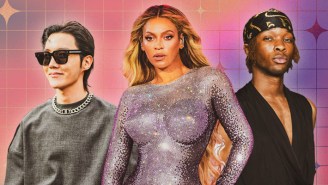Saul Goodman is a persona. He’s the product of pain and rejection. He may be funny and successful and great at his job, but he’s also a profoundly sad man. Better Call Saul is a journey through the pain and heartbreak that transforms the naive, hopeful, people-pleasing Jimmy McGill into the man we know from Breaking Bad. At its heart, Better Call Saul is a tragedy — a collection of rejections that eventually transform McGill into Goodman.
Thankfully, Vince Gilligan and Peter Gould are able to take our minds off some of the heartbreak each week by dropping interesting details, callbacks, and Easter Eggs that we can appreciate as we absorb the slowly unfolding tragedy. As we did last year, we’ll return each week and take a deeper look at each episode and pick up on the details that may be missed with only one viewing. Why? Because Gilligan and Gould are generous enough to give us layers that can be peeled back. That’s not true of many shows, so we should take advantage.
The following details were gleaned largely from rewatching “Switch” several times, listening to Kelly Dixon’s excellent Better Call Saul Insider podcast with Gilligan and Gould, and scouring the internet for other details and theories. Hyperlinks are to the Better Call Saul Insider podcast unless otherwise noted.
1. “SG Was Here”
Let’s start with the opening scene, which takes us to Omaha and “Gene” — formerly Saul Goodman, formerly Jimmy McGill — working at a Cinnabon. This scene exists mostly to remind us of where Jimmy McGill eventually ends up, although there’s a moment in this sequence that’s called back at the end of the episode (see #10).
Additionally, while trapped in the Dumpster room, he scrawls the following:
Viewers can interpret that any way they’d like, of course, but the writer and director of the episode, Thomas Schnauz, interprets it to mean that “Saul Goodman was here,” and he is no longer. In other words, there’s nothing left of Saul Goodman inside of this man, Gene. Saul Goodman has checked out for good.
That’s abundantly clear in this shot. There’s no trace of Goodman.
2. “Skribe”
Some may have also picked up on this other tag: Skribe. I’ve been following that one for a while, as it appeared in both Breaking Bad and in the first season of Better Call Saul.
Here it is in Breaking Bad, in a room Jessie was in.
Here it is last season.
And here it is in this week’s episode, “Switch.”
In his Film Schlubs podcast — posting later this week — with Vince Gilligan’s assistant, Jenn Carrol, Brian Davids asked about “Skribe.” Here’s the response he received:
Brian Davids: I view ‘SKRIBE’ as another visual motif such as the rowboat painting that followed Walt around throughout Breaking Bad. Is ‘SKRIBE,’ the graffiti, something that we should be obsessing over?
Jenn Carroll: Our art department has a wonderful person that does a lot of this graffiti for us. That has stayed the same over the last couple years and so, sometimes, there will be repeated tags. The art department is pretty conscious about not repeating tags anymore because of people thinking the “JP” is a Jesse Pinkman thing. Now that we know people are watching so closely, the art department is really conscious to try not to tell a story within a story as far as the graffiti in the background goes. But we want that graffiti to be there because it adds so much flavor to the set. So, I would say you’re probably okay not obsessing over that one. IF they change their minds though, I could be handing you a red herring.
3. Davis & Main
What’s most interesting about the first present-day scene is that, as originally written, Saul never went inside to reject the offer from Davis & Main. After standing in the parking lot for a moment and contemplating his next step, he returned to his car and drove away.
However, the writers later revised it and added that entire scene inside with the partners from Davis & Main to demonstrate to the audience how important Kim is to Saul. Inside, Saul asks if their relationship hinges on whether he takes the job, and when Kim says, “One thing has nothing to do with the other,” it comes as a huge relief to Jimmy, because now he knows that he still has a shot with Kim even after he does what he wanted to do from the beginning: Reject the job. Had she said that their relationship depended upon him taking the job, he’d have accepted it right then and there. Over the course of the episode, of course, he realizes that — in spite of what Kim initially told him — their relationship is predicated on him working for Davis & Main, which is why he returned to the firm to accept the job. He did it for Kim.
4. “Smoke on the Water”
The song with the incredibly recognizable riff that Jimmy was humming in his car was Deep Purple’s “Smoke on the Water,” the lyrics of which relay the true story of the band members watching a casino burn to the ground from their hotel and seeing the smoke from the fire float across Lake Geneva. I have no idea if that has any meaning at all, but if we see a casino burn to the ground in episode six, we’re gonna know how deeply Vince Gilligan and Co. buried that foreshadowing.
5. The Dumpster Room
Here’s a little behind-the-scenes note of interest: Inside the building pictured here — where Daniel Warmolt and Nacho met — is the Dumpster room used in the beginning of the episode in Omaha.
6. Ken
Some of you may recognize this douchebag, Ken, from an episode of Breaking Bad.
His car did not fare well in his exchange with Walter White.
According to Vince Gilligan, the actor who played Ken, Kyle Bornheimer, is anything but a douchebag. Then again, I doubt Gilligan has ever spoken ill of anyone in his life.
7. Tequila
As Danger already pointed out, the expensive tequila in the episode is also a callback to Breaking Bad. It was the tequila Gus used to poison Don Eladio and the members of the Mexican cartel. They didn’t have the bottle from Breaking Bad anymore, so as Vince Gilligan noted in the Better Call Saul Insider podcast, they used a 3-D printer to recreate it, because technology is “cool.”
8. Officer Saxton
Officer Saxton (Stoney Westmoreland), who visited Daniel Warmolt’s house, is also a character who originated on Breaking Bad. He came to the White home when Skylar called to have the cops remove Walter from her house.
9. Archuleta
Brian Davids over on Film Schlubs also picked up on the fact that one of the associates at Davis & Main, Brian Archuleta, shares the same last name as Hugo Archuleta, a former custodian and janitor at J. P. Wynne High School, where Walter White taught. Davids posits that perhaps Brian got into a legal career because of the legal woes of his father or brother, Hugo.
Makes sense to me.
Did Brian Archuleta pursue a career in law due to the legal woes of his dad/brother, Hugo Archuleta? #BetterCallSaul pic.twitter.com/s7lQt2MaMn
— Brian Davids (@PickYourBrian) February 16, 2016
10. It’s All About Timing
Daniel’s registration is just a reminder of the timeline. The registration expires in 2005, and it’s a new car, so they’re in 2004. Breaking Bad begins in 2008. The writers and Bob Odenkirk has said that they’d like Saul to run for three or four seasons, which means that each season could potentially cover a year in Jimmy’s life before the events of Breaking Bad. Of course, he wasn’t introduced to Breaking Bad until the second season, but by then, he was already fully Saul.
11. Lights Out
Finally, the light switch Jimmy flicks off at the end of the episode, despite the warning not to, doesn’t actually do anything (nor will it pop up again in the series). It’s designed merely to demonstrate how much Jimmy evolved from his first day at Davis & Main to the moment he was confronted with an emergency exit as Gene while trapped in the Dumpster room. Jimmy is brave enough to break the rules and risk the consequences. Gene is terrified of breaking the rules and calling attention to himself. Meanwhile, Saul would’ve pushed open the emergency door, waited for the police, and probably found a way to pin the blame on them. It’s once again an illustration of how far Jimmy has come and how far he fall as Gene in Omaha.
(Via Better Call Saul Insider)






